Berghuis v. Thompkins: Criminal Justice Case and Analysis
VerifiedAdded on 2023/01/20
|17
|5089
|52
Case Study
AI Summary
This case study analyzes the Supreme Court case of Berghuis v. Thompkins (2010), which addressed the issue of whether a suspect validly waived their Miranda rights. The case involved a suspect who, after being read his Miranda rights, remained largely silent during interrogation but eventually answered one question. The Court held that the suspect had implicitly waived his right to remain silent by responding to the question, establishing that a waiver can be inferred from a suspect's conduct, even without an explicit statement. The analysis explores the facts of the case, the procedural history, the arguments of both sides, and the Court's reasoning, focusing on the implications for interrogation practices and the interpretation of Miranda rights. The case underscores the importance of clear invocation of rights and the potential for implied waivers based on a suspect's behavior during questioning. The case also touches on the issue of ineffective assistance of counsel.

Criminal Justice
Student Name
College
Student Name
College
Paraphrase This Document
Need a fresh take? Get an instant paraphrase of this document with our AI Paraphraser

Berghuis v. Thompkins
560.U.S.370
2010
Synopsis
In Berghius v. Thompson case of the United States, the Supreme Court considered the
issue as to whether police may question a suspect in custody in instances where the suspect after
he or she receives the Miranda warnings has neither waived nor expressly made known use of his
right to remain silent.
In considering the matter, the court was basically determining on what the default rule
should be, after the Miranda rules are communicated to the suspect and understood. Therefore,
the question is; should the officer presume that the suspect is willing or unwilling to undergo the
interrogation? (Chakarian, 2011).
Character of Action
The case on the instance went to the trial court in the year 2002 where it held Thompkins
guilty of the offence of murder. Later in 2004, an appeal was made in the Michigan court of
appeals where in giving its ruling, it affirmed the sentence given and rejected the claims that
were raised regarding misconduct during prosecution and the violation of Thompkins Miranda
rights. Following that, the United States Eastern District Court of Michigan in 2005 did not allow
the prayer by Thompkins for grant of a habeas corpus writ.
On the other hand, the sixth circuit court of appeal reversed the decision of the district
court in 2006 and therefore granted him the prayer regarding the motion of Miranda and the
560.U.S.370
2010
Synopsis
In Berghius v. Thompson case of the United States, the Supreme Court considered the
issue as to whether police may question a suspect in custody in instances where the suspect after
he or she receives the Miranda warnings has neither waived nor expressly made known use of his
right to remain silent.
In considering the matter, the court was basically determining on what the default rule
should be, after the Miranda rules are communicated to the suspect and understood. Therefore,
the question is; should the officer presume that the suspect is willing or unwilling to undergo the
interrogation? (Chakarian, 2011).
Character of Action
The case on the instance went to the trial court in the year 2002 where it held Thompkins
guilty of the offence of murder. Later in 2004, an appeal was made in the Michigan court of
appeals where in giving its ruling, it affirmed the sentence given and rejected the claims that
were raised regarding misconduct during prosecution and the violation of Thompkins Miranda
rights. Following that, the United States Eastern District Court of Michigan in 2005 did not allow
the prayer by Thompkins for grant of a habeas corpus writ.
On the other hand, the sixth circuit court of appeal reversed the decision of the district
court in 2006 and therefore granted him the prayer regarding the motion of Miranda and the

ineffective claim. Following this, an appeal was made to the Supreme Court by Mary Berghuis
who was holding Thompkins in the prison warden and by the state of Michigan
Facts of the Case
The facts to be discussed follows an incident that took place on 10th January 2000. The
incident took place in Southfield Michigan along a strip maII parking. The circumstances of the
incident are that; Samuel morris and Frederick France were driving through the mentioned strip
when bullets were sprayed on them resulting to the death of Samuel while Frederick sustained
some severe injuries.
Following this, Frederick indicated to the police that some men had gotten into a van and
pulled up alongside the car in which Morris and Frederick were. Shortly after, a male person
seated in the seat for passengers removed a pistol and lashed the car they were in with bullets.
Following the incident, the officers investigated which led to Van Chester Thompkins
And Eric Purifoy as the suspects. Later, Eric was arrested on the allegations and charged with
committing the offence of murder, that is, murder of Morris. In addition to that, he was charged
with the offence of assault and possessing weapons of the alleged offence. Subsequently, he was
acquitted of both charges and let free. On the other hand, Thompkins had managed to avoid the
police until 19th of February 2001 when he was arrested. This exactly amounted to not less than a
year after the incidence had taken place and six months after Erick had been acquitted of murder.
Following the arrest, Thompkins was interrogated by the police department of Southfield
3 days after the arrest at Ohio jail. At the start of the interrogation, the detective in charge that is,
Christopher Helgart, read to Thompkins his rights in which Thompkins responded verbally
indicating that he understood. However, he did not agree to signing a form that was to prove that
who was holding Thompkins in the prison warden and by the state of Michigan
Facts of the Case
The facts to be discussed follows an incident that took place on 10th January 2000. The
incident took place in Southfield Michigan along a strip maII parking. The circumstances of the
incident are that; Samuel morris and Frederick France were driving through the mentioned strip
when bullets were sprayed on them resulting to the death of Samuel while Frederick sustained
some severe injuries.
Following this, Frederick indicated to the police that some men had gotten into a van and
pulled up alongside the car in which Morris and Frederick were. Shortly after, a male person
seated in the seat for passengers removed a pistol and lashed the car they were in with bullets.
Following the incident, the officers investigated which led to Van Chester Thompkins
And Eric Purifoy as the suspects. Later, Eric was arrested on the allegations and charged with
committing the offence of murder, that is, murder of Morris. In addition to that, he was charged
with the offence of assault and possessing weapons of the alleged offence. Subsequently, he was
acquitted of both charges and let free. On the other hand, Thompkins had managed to avoid the
police until 19th of February 2001 when he was arrested. This exactly amounted to not less than a
year after the incidence had taken place and six months after Erick had been acquitted of murder.
Following the arrest, Thompkins was interrogated by the police department of Southfield
3 days after the arrest at Ohio jail. At the start of the interrogation, the detective in charge that is,
Christopher Helgart, read to Thompkins his rights in which Thompkins responded verbally
indicating that he understood. However, he did not agree to signing a form that was to prove that
⊘ This is a preview!⊘
Do you want full access?
Subscribe today to unlock all pages.

Trusted by 1+ million students worldwide
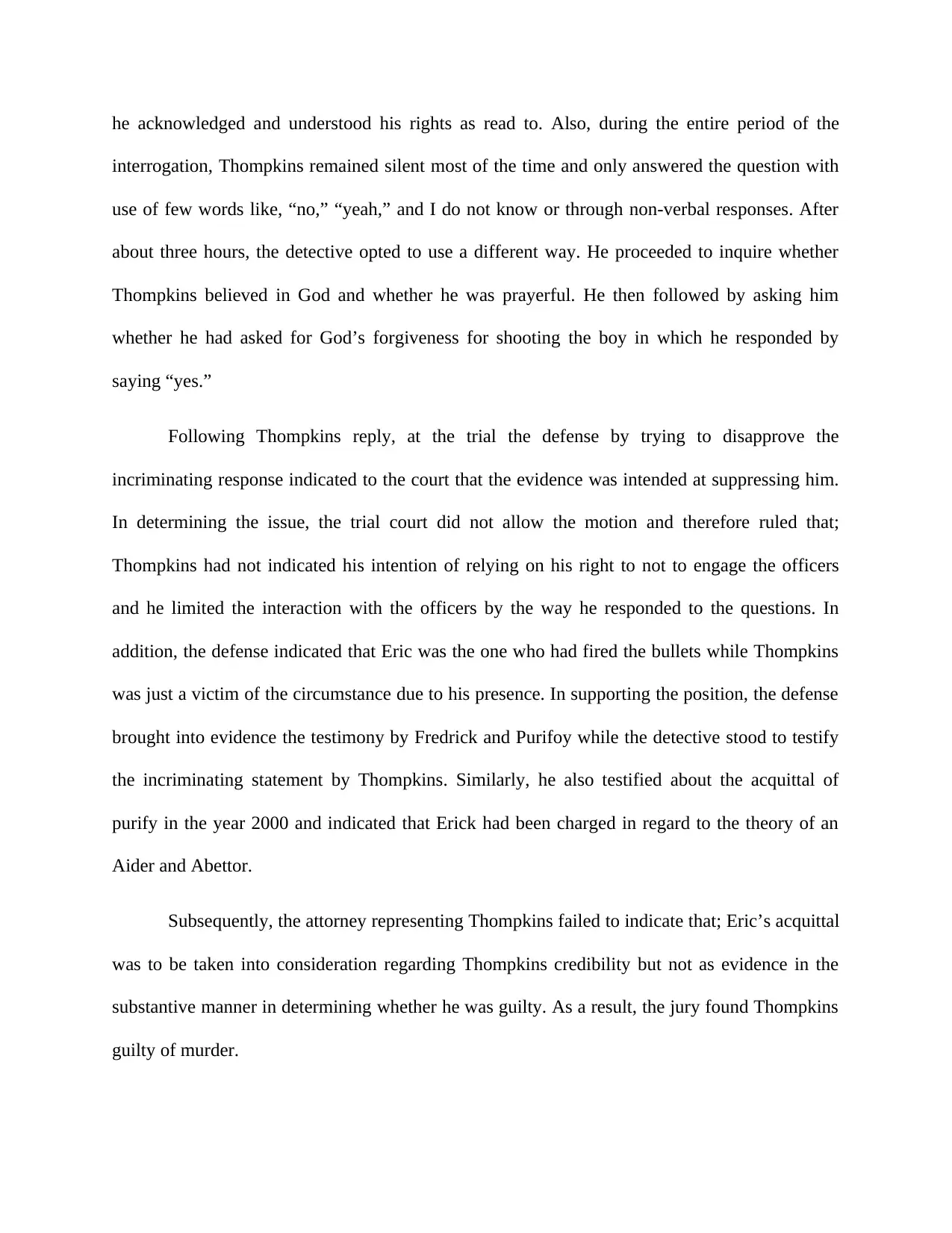
he acknowledged and understood his rights as read to. Also, during the entire period of the
interrogation, Thompkins remained silent most of the time and only answered the question with
use of few words like, “no,” “yeah,” and I do not know or through non-verbal responses. After
about three hours, the detective opted to use a different way. He proceeded to inquire whether
Thompkins believed in God and whether he was prayerful. He then followed by asking him
whether he had asked for God’s forgiveness for shooting the boy in which he responded by
saying “yes.”
Following Thompkins reply, at the trial the defense by trying to disapprove the
incriminating response indicated to the court that the evidence was intended at suppressing him.
In determining the issue, the trial court did not allow the motion and therefore ruled that;
Thompkins had not indicated his intention of relying on his right to not to engage the officers
and he limited the interaction with the officers by the way he responded to the questions. In
addition, the defense indicated that Eric was the one who had fired the bullets while Thompkins
was just a victim of the circumstance due to his presence. In supporting the position, the defense
brought into evidence the testimony by Fredrick and Purifoy while the detective stood to testify
the incriminating statement by Thompkins. Similarly, he also testified about the acquittal of
purify in the year 2000 and indicated that Erick had been charged in regard to the theory of an
Aider and Abettor.
Subsequently, the attorney representing Thompkins failed to indicate that; Eric’s acquittal
was to be taken into consideration regarding Thompkins credibility but not as evidence in the
substantive manner in determining whether he was guilty. As a result, the jury found Thompkins
guilty of murder.
interrogation, Thompkins remained silent most of the time and only answered the question with
use of few words like, “no,” “yeah,” and I do not know or through non-verbal responses. After
about three hours, the detective opted to use a different way. He proceeded to inquire whether
Thompkins believed in God and whether he was prayerful. He then followed by asking him
whether he had asked for God’s forgiveness for shooting the boy in which he responded by
saying “yes.”
Following Thompkins reply, at the trial the defense by trying to disapprove the
incriminating response indicated to the court that the evidence was intended at suppressing him.
In determining the issue, the trial court did not allow the motion and therefore ruled that;
Thompkins had not indicated his intention of relying on his right to not to engage the officers
and he limited the interaction with the officers by the way he responded to the questions. In
addition, the defense indicated that Eric was the one who had fired the bullets while Thompkins
was just a victim of the circumstance due to his presence. In supporting the position, the defense
brought into evidence the testimony by Fredrick and Purifoy while the detective stood to testify
the incriminating statement by Thompkins. Similarly, he also testified about the acquittal of
purify in the year 2000 and indicated that Erick had been charged in regard to the theory of an
Aider and Abettor.
Subsequently, the attorney representing Thompkins failed to indicate that; Eric’s acquittal
was to be taken into consideration regarding Thompkins credibility but not as evidence in the
substantive manner in determining whether he was guilty. As a result, the jury found Thompkins
guilty of murder.
Paraphrase This Document
Need a fresh take? Get an instant paraphrase of this document with our AI Paraphraser
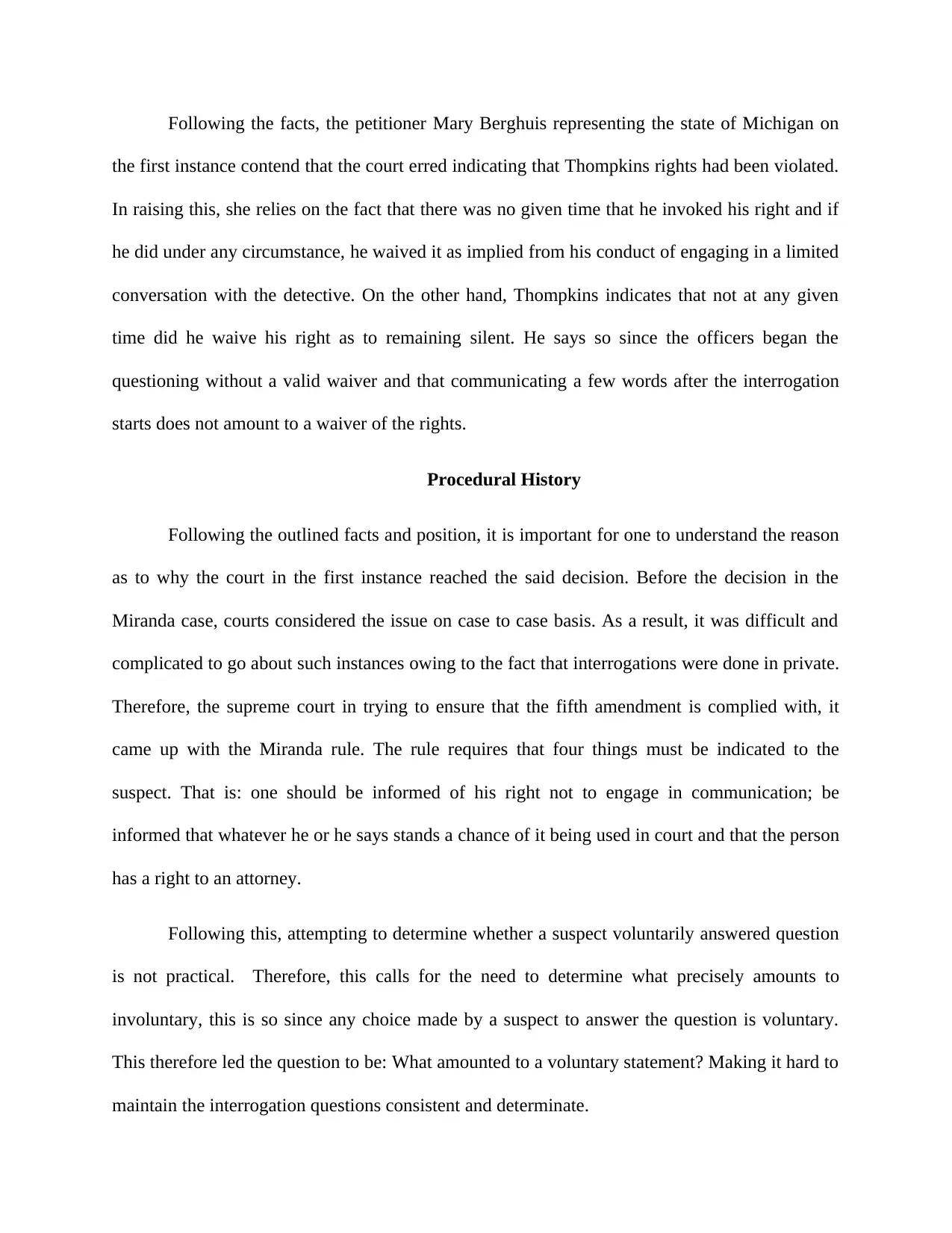
Following the facts, the petitioner Mary Berghuis representing the state of Michigan on
the first instance contend that the court erred indicating that Thompkins rights had been violated.
In raising this, she relies on the fact that there was no given time that he invoked his right and if
he did under any circumstance, he waived it as implied from his conduct of engaging in a limited
conversation with the detective. On the other hand, Thompkins indicates that not at any given
time did he waive his right as to remaining silent. He says so since the officers began the
questioning without a valid waiver and that communicating a few words after the interrogation
starts does not amount to a waiver of the rights.
Procedural History
Following the outlined facts and position, it is important for one to understand the reason
as to why the court in the first instance reached the said decision. Before the decision in the
Miranda case, courts considered the issue on case to case basis. As a result, it was difficult and
complicated to go about such instances owing to the fact that interrogations were done in private.
Therefore, the supreme court in trying to ensure that the fifth amendment is complied with, it
came up with the Miranda rule. The rule requires that four things must be indicated to the
suspect. That is: one should be informed of his right not to engage in communication; be
informed that whatever he or he says stands a chance of it being used in court and that the person
has a right to an attorney.
Following this, attempting to determine whether a suspect voluntarily answered question
is not practical. Therefore, this calls for the need to determine what precisely amounts to
involuntary, this is so since any choice made by a suspect to answer the question is voluntary.
This therefore led the question to be: What amounted to a voluntary statement? Making it hard to
maintain the interrogation questions consistent and determinate.
the first instance contend that the court erred indicating that Thompkins rights had been violated.
In raising this, she relies on the fact that there was no given time that he invoked his right and if
he did under any circumstance, he waived it as implied from his conduct of engaging in a limited
conversation with the detective. On the other hand, Thompkins indicates that not at any given
time did he waive his right as to remaining silent. He says so since the officers began the
questioning without a valid waiver and that communicating a few words after the interrogation
starts does not amount to a waiver of the rights.
Procedural History
Following the outlined facts and position, it is important for one to understand the reason
as to why the court in the first instance reached the said decision. Before the decision in the
Miranda case, courts considered the issue on case to case basis. As a result, it was difficult and
complicated to go about such instances owing to the fact that interrogations were done in private.
Therefore, the supreme court in trying to ensure that the fifth amendment is complied with, it
came up with the Miranda rule. The rule requires that four things must be indicated to the
suspect. That is: one should be informed of his right not to engage in communication; be
informed that whatever he or he says stands a chance of it being used in court and that the person
has a right to an attorney.
Following this, attempting to determine whether a suspect voluntarily answered question
is not practical. Therefore, this calls for the need to determine what precisely amounts to
involuntary, this is so since any choice made by a suspect to answer the question is voluntary.
This therefore led the question to be: What amounted to a voluntary statement? Making it hard to
maintain the interrogation questions consistent and determinate.
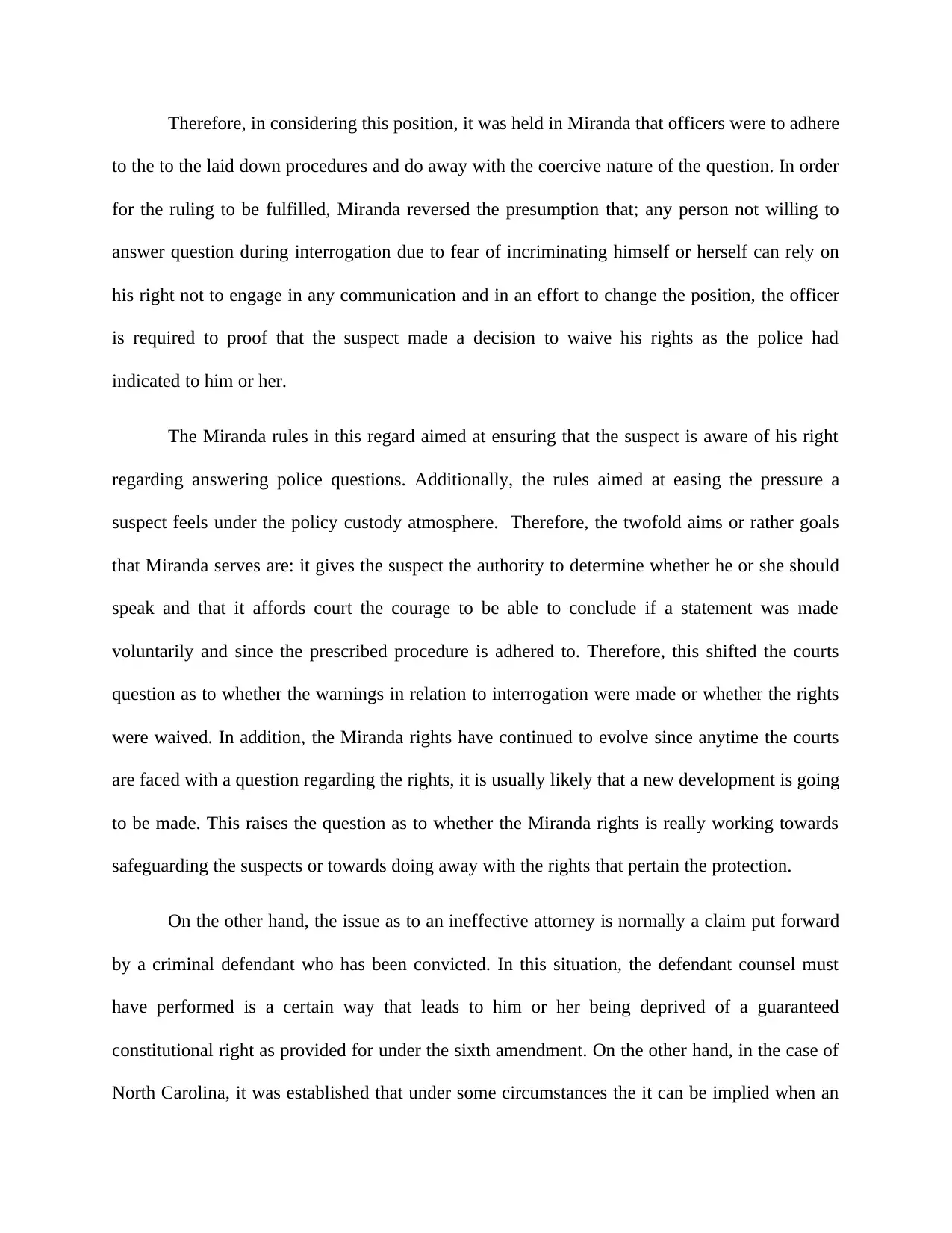
Therefore, in considering this position, it was held in Miranda that officers were to adhere
to the to the laid down procedures and do away with the coercive nature of the question. In order
for the ruling to be fulfilled, Miranda reversed the presumption that; any person not willing to
answer question during interrogation due to fear of incriminating himself or herself can rely on
his right not to engage in any communication and in an effort to change the position, the officer
is required to proof that the suspect made a decision to waive his rights as the police had
indicated to him or her.
The Miranda rules in this regard aimed at ensuring that the suspect is aware of his right
regarding answering police questions. Additionally, the rules aimed at easing the pressure a
suspect feels under the policy custody atmosphere. Therefore, the twofold aims or rather goals
that Miranda serves are: it gives the suspect the authority to determine whether he or she should
speak and that it affords court the courage to be able to conclude if a statement was made
voluntarily and since the prescribed procedure is adhered to. Therefore, this shifted the courts
question as to whether the warnings in relation to interrogation were made or whether the rights
were waived. In addition, the Miranda rights have continued to evolve since anytime the courts
are faced with a question regarding the rights, it is usually likely that a new development is going
to be made. This raises the question as to whether the Miranda rights is really working towards
safeguarding the suspects or towards doing away with the rights that pertain the protection.
On the other hand, the issue as to an ineffective attorney is normally a claim put forward
by a criminal defendant who has been convicted. In this situation, the defendant counsel must
have performed is a certain way that leads to him or her being deprived of a guaranteed
constitutional right as provided for under the sixth amendment. On the other hand, in the case of
North Carolina, it was established that under some circumstances the it can be implied when an
to the to the laid down procedures and do away with the coercive nature of the question. In order
for the ruling to be fulfilled, Miranda reversed the presumption that; any person not willing to
answer question during interrogation due to fear of incriminating himself or herself can rely on
his right not to engage in any communication and in an effort to change the position, the officer
is required to proof that the suspect made a decision to waive his rights as the police had
indicated to him or her.
The Miranda rules in this regard aimed at ensuring that the suspect is aware of his right
regarding answering police questions. Additionally, the rules aimed at easing the pressure a
suspect feels under the policy custody atmosphere. Therefore, the twofold aims or rather goals
that Miranda serves are: it gives the suspect the authority to determine whether he or she should
speak and that it affords court the courage to be able to conclude if a statement was made
voluntarily and since the prescribed procedure is adhered to. Therefore, this shifted the courts
question as to whether the warnings in relation to interrogation were made or whether the rights
were waived. In addition, the Miranda rights have continued to evolve since anytime the courts
are faced with a question regarding the rights, it is usually likely that a new development is going
to be made. This raises the question as to whether the Miranda rights is really working towards
safeguarding the suspects or towards doing away with the rights that pertain the protection.
On the other hand, the issue as to an ineffective attorney is normally a claim put forward
by a criminal defendant who has been convicted. In this situation, the defendant counsel must
have performed is a certain way that leads to him or her being deprived of a guaranteed
constitutional right as provided for under the sixth amendment. On the other hand, in the case of
North Carolina, it was established that under some circumstances the it can be implied when an
⊘ This is a preview!⊘
Do you want full access?
Subscribe today to unlock all pages.

Trusted by 1+ million students worldwide

individuals waives the right while in the butler case it was stated that silence is not enough to
constitute a waive but the same can be implied in combination of a suspect being able to
understand and any other conduct that implies otherwise.
Issues
Following the facts of the case, the following issues were brought into question:
(A) Whether, for a statement to be used during trial, the officers are required
to have a waiver expressly made as to the right to not to engage in communication once
he is made aware and understands his Miranda rights?
(B) Whether the court of the State was irrational by holding that Thompkins
had not suffered any injury because of his attorney failing to object to the prosecutions
closing statement?
The Courts Decision: By Justice Kennedy
The United States Supreme Court reversed and remanded the decision of the Sixth
Circuits Court
Issue A: No. Reason
Justice M. Kennedy gave three major reasons as to why it gave the decision indicated on
Miranda holding. First, Thompkins by choosing to remain silent during most of the interrogation
time did not necessarily imply that he had intended to use his not to engage in communication
for Miranda purposes. The decision of the court in the (1994) case of Davis v. U. S. 512
necessitates that, one should provide an “unambiguous” use pertaining the right. In this instance,
constitute a waive but the same can be implied in combination of a suspect being able to
understand and any other conduct that implies otherwise.
Issues
Following the facts of the case, the following issues were brought into question:
(A) Whether, for a statement to be used during trial, the officers are required
to have a waiver expressly made as to the right to not to engage in communication once
he is made aware and understands his Miranda rights?
(B) Whether the court of the State was irrational by holding that Thompkins
had not suffered any injury because of his attorney failing to object to the prosecutions
closing statement?
The Courts Decision: By Justice Kennedy
The United States Supreme Court reversed and remanded the decision of the Sixth
Circuits Court
Issue A: No. Reason
Justice M. Kennedy gave three major reasons as to why it gave the decision indicated on
Miranda holding. First, Thompkins by choosing to remain silent during most of the interrogation
time did not necessarily imply that he had intended to use his not to engage in communication
for Miranda purposes. The decision of the court in the (1994) case of Davis v. U. S. 512
necessitates that, one should provide an “unambiguous” use pertaining the right. In this instance,
Paraphrase This Document
Need a fresh take? Get an instant paraphrase of this document with our AI Paraphraser
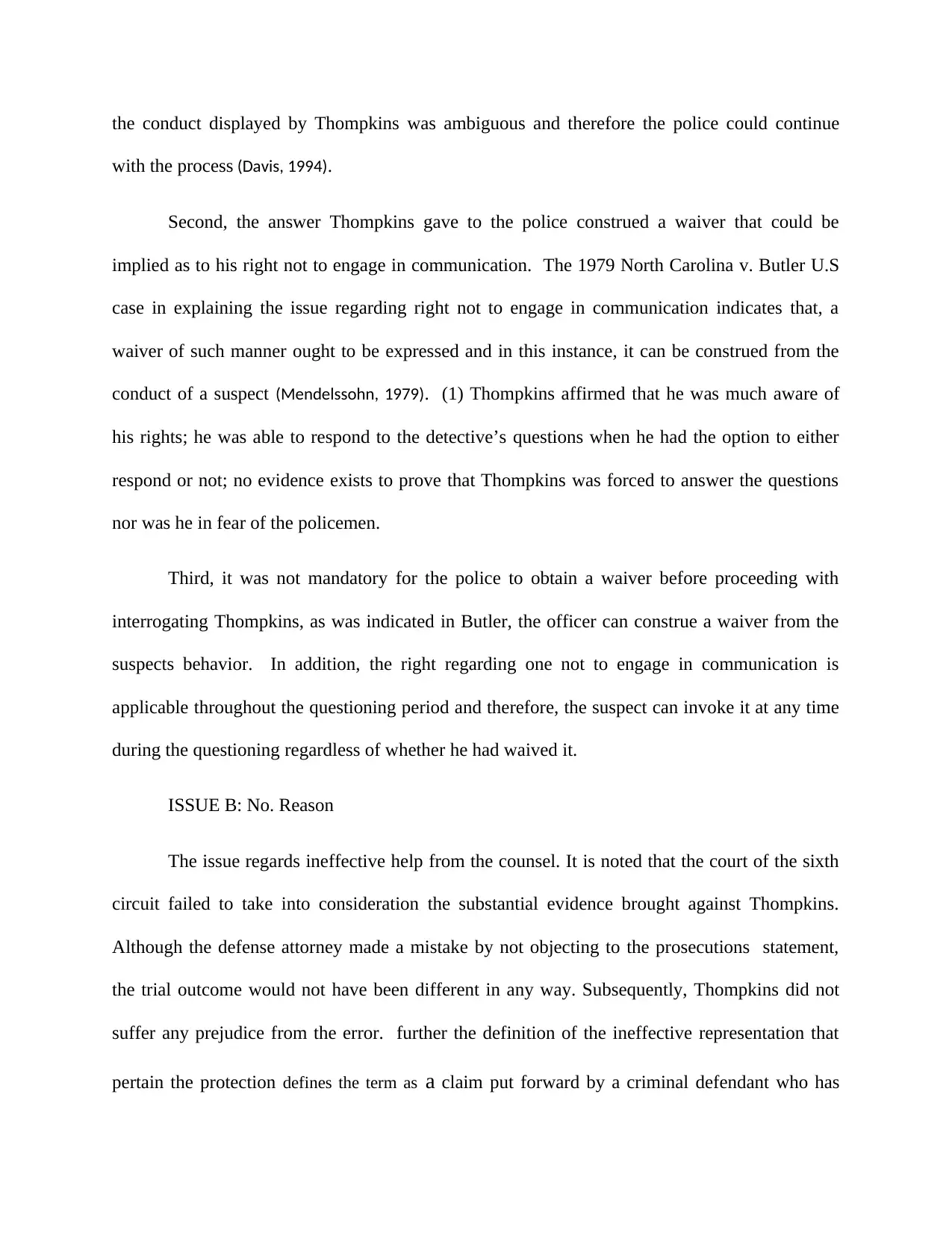
the conduct displayed by Thompkins was ambiguous and therefore the police could continue
with the process (Davis, 1994).
Second, the answer Thompkins gave to the police construed a waiver that could be
implied as to his right not to engage in communication. The 1979 North Carolina v. Butler U.S
case in explaining the issue regarding right not to engage in communication indicates that, a
waiver of such manner ought to be expressed and in this instance, it can be construed from the
conduct of a suspect (Mendelssohn, 1979). (1) Thompkins affirmed that he was much aware of
his rights; he was able to respond to the detective’s questions when he had the option to either
respond or not; no evidence exists to prove that Thompkins was forced to answer the questions
nor was he in fear of the policemen.
Third, it was not mandatory for the police to obtain a waiver before proceeding with
interrogating Thompkins, as was indicated in Butler, the officer can construe a waiver from the
suspects behavior. In addition, the right regarding one not to engage in communication is
applicable throughout the questioning period and therefore, the suspect can invoke it at any time
during the questioning regardless of whether he had waived it.
ISSUE B: No. Reason
The issue regards ineffective help from the counsel. It is noted that the court of the sixth
circuit failed to take into consideration the substantial evidence brought against Thompkins.
Although the defense attorney made a mistake by not objecting to the prosecutions statement,
the trial outcome would not have been different in any way. Subsequently, Thompkins did not
suffer any prejudice from the error. further the definition of the ineffective representation that
pertain the protection defines the term as a claim put forward by a criminal defendant who has
with the process (Davis, 1994).
Second, the answer Thompkins gave to the police construed a waiver that could be
implied as to his right not to engage in communication. The 1979 North Carolina v. Butler U.S
case in explaining the issue regarding right not to engage in communication indicates that, a
waiver of such manner ought to be expressed and in this instance, it can be construed from the
conduct of a suspect (Mendelssohn, 1979). (1) Thompkins affirmed that he was much aware of
his rights; he was able to respond to the detective’s questions when he had the option to either
respond or not; no evidence exists to prove that Thompkins was forced to answer the questions
nor was he in fear of the policemen.
Third, it was not mandatory for the police to obtain a waiver before proceeding with
interrogating Thompkins, as was indicated in Butler, the officer can construe a waiver from the
suspects behavior. In addition, the right regarding one not to engage in communication is
applicable throughout the questioning period and therefore, the suspect can invoke it at any time
during the questioning regardless of whether he had waived it.
ISSUE B: No. Reason
The issue regards ineffective help from the counsel. It is noted that the court of the sixth
circuit failed to take into consideration the substantial evidence brought against Thompkins.
Although the defense attorney made a mistake by not objecting to the prosecutions statement,
the trial outcome would not have been different in any way. Subsequently, Thompkins did not
suffer any prejudice from the error. further the definition of the ineffective representation that
pertain the protection defines the term as a claim put forward by a criminal defendant who has
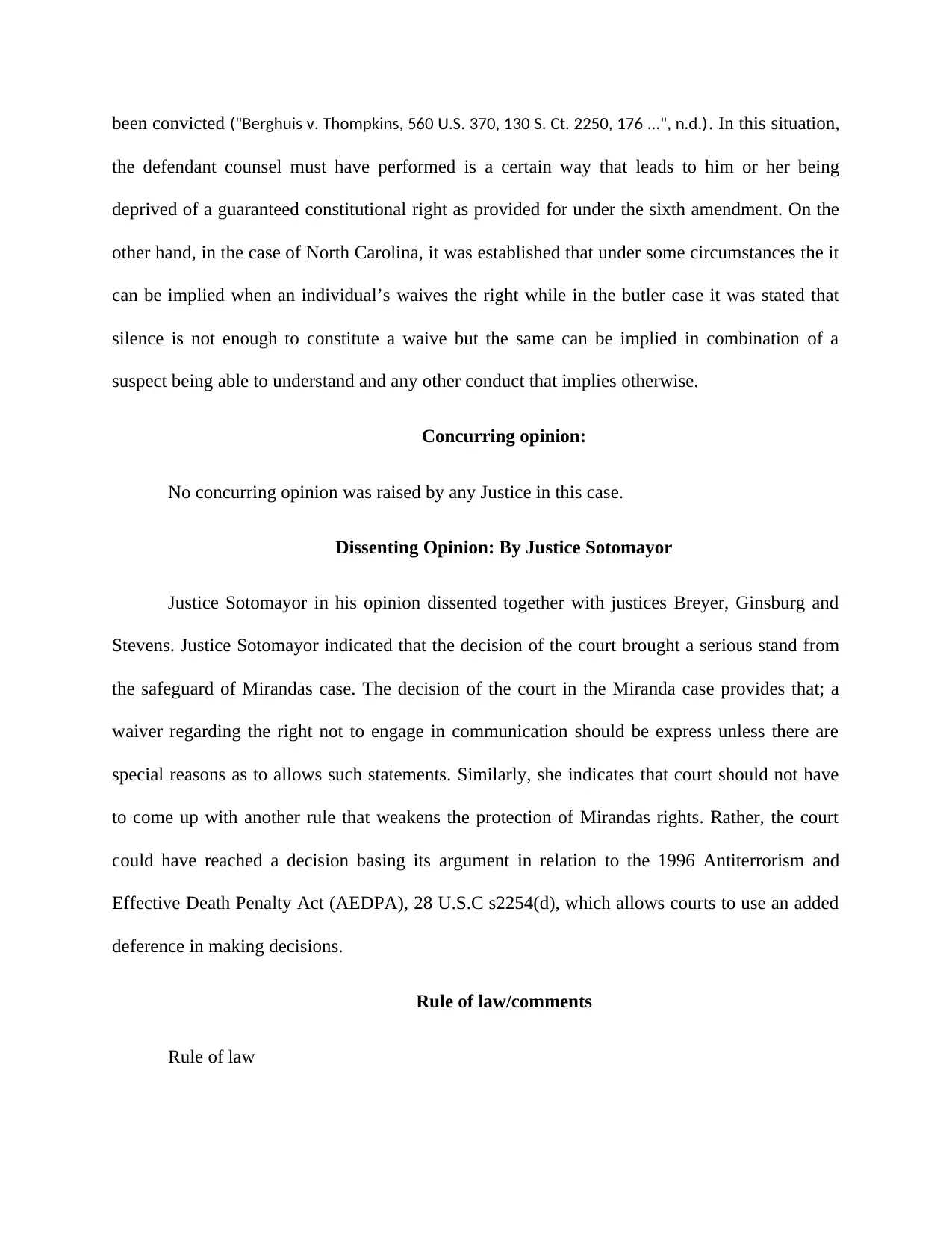
been convicted ("Berghuis v. Thompkins, 560 U.S. 370, 130 S. Ct. 2250, 176 ...", n.d.). In this situation,
the defendant counsel must have performed is a certain way that leads to him or her being
deprived of a guaranteed constitutional right as provided for under the sixth amendment. On the
other hand, in the case of North Carolina, it was established that under some circumstances the it
can be implied when an individual’s waives the right while in the butler case it was stated that
silence is not enough to constitute a waive but the same can be implied in combination of a
suspect being able to understand and any other conduct that implies otherwise.
Concurring opinion:
No concurring opinion was raised by any Justice in this case.
Dissenting Opinion: By Justice Sotomayor
Justice Sotomayor in his opinion dissented together with justices Breyer, Ginsburg and
Stevens. Justice Sotomayor indicated that the decision of the court brought a serious stand from
the safeguard of Mirandas case. The decision of the court in the Miranda case provides that; a
waiver regarding the right not to engage in communication should be express unless there are
special reasons as to allows such statements. Similarly, she indicates that court should not have
to come up with another rule that weakens the protection of Mirandas rights. Rather, the court
could have reached a decision basing its argument in relation to the 1996 Antiterrorism and
Effective Death Penalty Act (AEDPA), 28 U.S.C s2254(d), which allows courts to use an added
deference in making decisions.
Rule of law/comments
Rule of law
the defendant counsel must have performed is a certain way that leads to him or her being
deprived of a guaranteed constitutional right as provided for under the sixth amendment. On the
other hand, in the case of North Carolina, it was established that under some circumstances the it
can be implied when an individual’s waives the right while in the butler case it was stated that
silence is not enough to constitute a waive but the same can be implied in combination of a
suspect being able to understand and any other conduct that implies otherwise.
Concurring opinion:
No concurring opinion was raised by any Justice in this case.
Dissenting Opinion: By Justice Sotomayor
Justice Sotomayor in his opinion dissented together with justices Breyer, Ginsburg and
Stevens. Justice Sotomayor indicated that the decision of the court brought a serious stand from
the safeguard of Mirandas case. The decision of the court in the Miranda case provides that; a
waiver regarding the right not to engage in communication should be express unless there are
special reasons as to allows such statements. Similarly, she indicates that court should not have
to come up with another rule that weakens the protection of Mirandas rights. Rather, the court
could have reached a decision basing its argument in relation to the 1996 Antiterrorism and
Effective Death Penalty Act (AEDPA), 28 U.S.C s2254(d), which allows courts to use an added
deference in making decisions.
Rule of law/comments
Rule of law
⊘ This is a preview!⊘
Do you want full access?
Subscribe today to unlock all pages.

Trusted by 1+ million students worldwide
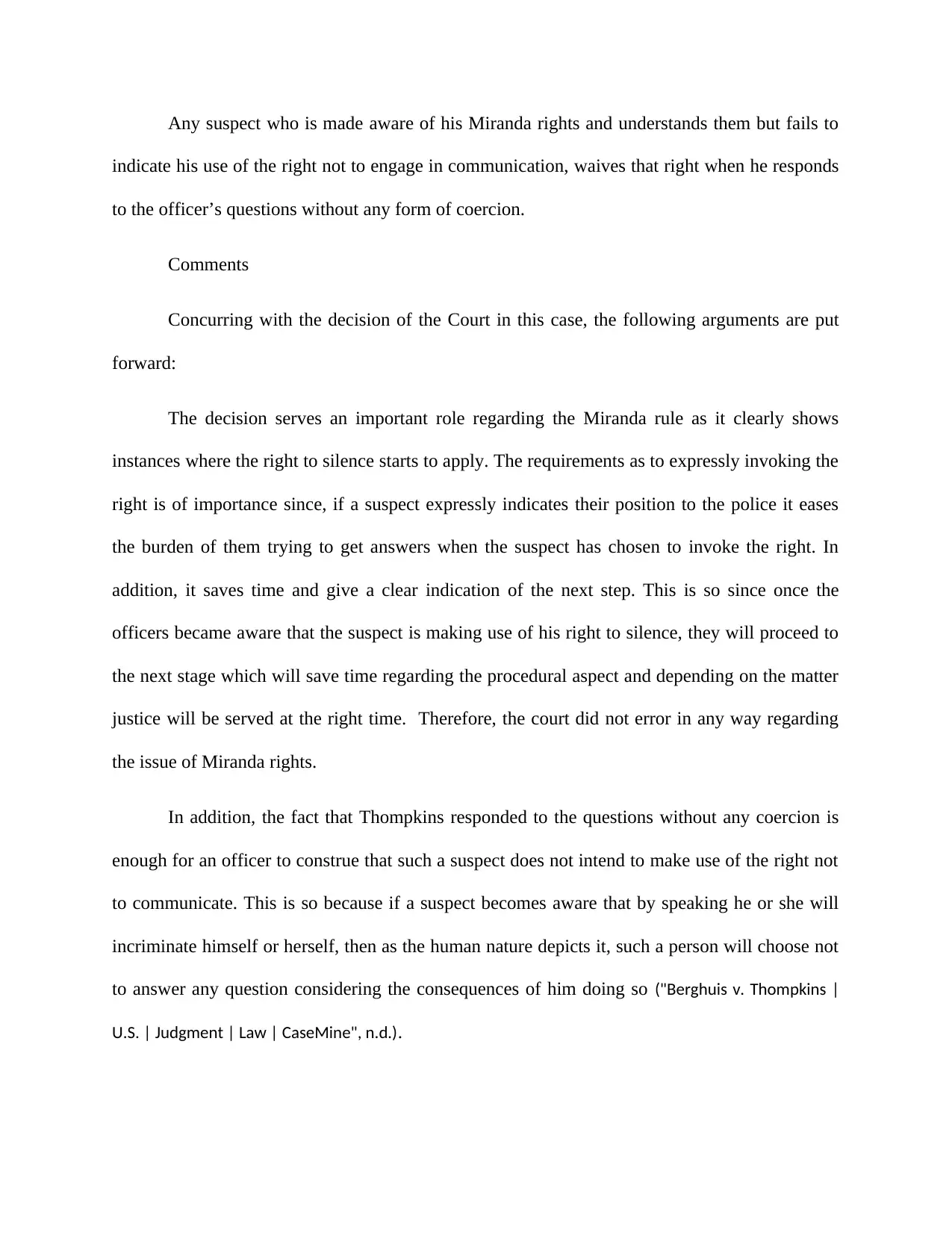
Any suspect who is made aware of his Miranda rights and understands them but fails to
indicate his use of the right not to engage in communication, waives that right when he responds
to the officer’s questions without any form of coercion.
Comments
Concurring with the decision of the Court in this case, the following arguments are put
forward:
The decision serves an important role regarding the Miranda rule as it clearly shows
instances where the right to silence starts to apply. The requirements as to expressly invoking the
right is of importance since, if a suspect expressly indicates their position to the police it eases
the burden of them trying to get answers when the suspect has chosen to invoke the right. In
addition, it saves time and give a clear indication of the next step. This is so since once the
officers became aware that the suspect is making use of his right to silence, they will proceed to
the next stage which will save time regarding the procedural aspect and depending on the matter
justice will be served at the right time. Therefore, the court did not error in any way regarding
the issue of Miranda rights.
In addition, the fact that Thompkins responded to the questions without any coercion is
enough for an officer to construe that such a suspect does not intend to make use of the right not
to communicate. This is so because if a suspect becomes aware that by speaking he or she will
incriminate himself or herself, then as the human nature depicts it, such a person will choose not
to answer any question considering the consequences of him doing so ("Berghuis v. Thompkins |
U.S. | Judgment | Law | CaseMine", n.d.).
indicate his use of the right not to engage in communication, waives that right when he responds
to the officer’s questions without any form of coercion.
Comments
Concurring with the decision of the Court in this case, the following arguments are put
forward:
The decision serves an important role regarding the Miranda rule as it clearly shows
instances where the right to silence starts to apply. The requirements as to expressly invoking the
right is of importance since, if a suspect expressly indicates their position to the police it eases
the burden of them trying to get answers when the suspect has chosen to invoke the right. In
addition, it saves time and give a clear indication of the next step. This is so since once the
officers became aware that the suspect is making use of his right to silence, they will proceed to
the next stage which will save time regarding the procedural aspect and depending on the matter
justice will be served at the right time. Therefore, the court did not error in any way regarding
the issue of Miranda rights.
In addition, the fact that Thompkins responded to the questions without any coercion is
enough for an officer to construe that such a suspect does not intend to make use of the right not
to communicate. This is so because if a suspect becomes aware that by speaking he or she will
incriminate himself or herself, then as the human nature depicts it, such a person will choose not
to answer any question considering the consequences of him doing so ("Berghuis v. Thompkins |
U.S. | Judgment | Law | CaseMine", n.d.).
Paraphrase This Document
Need a fresh take? Get an instant paraphrase of this document with our AI Paraphraser
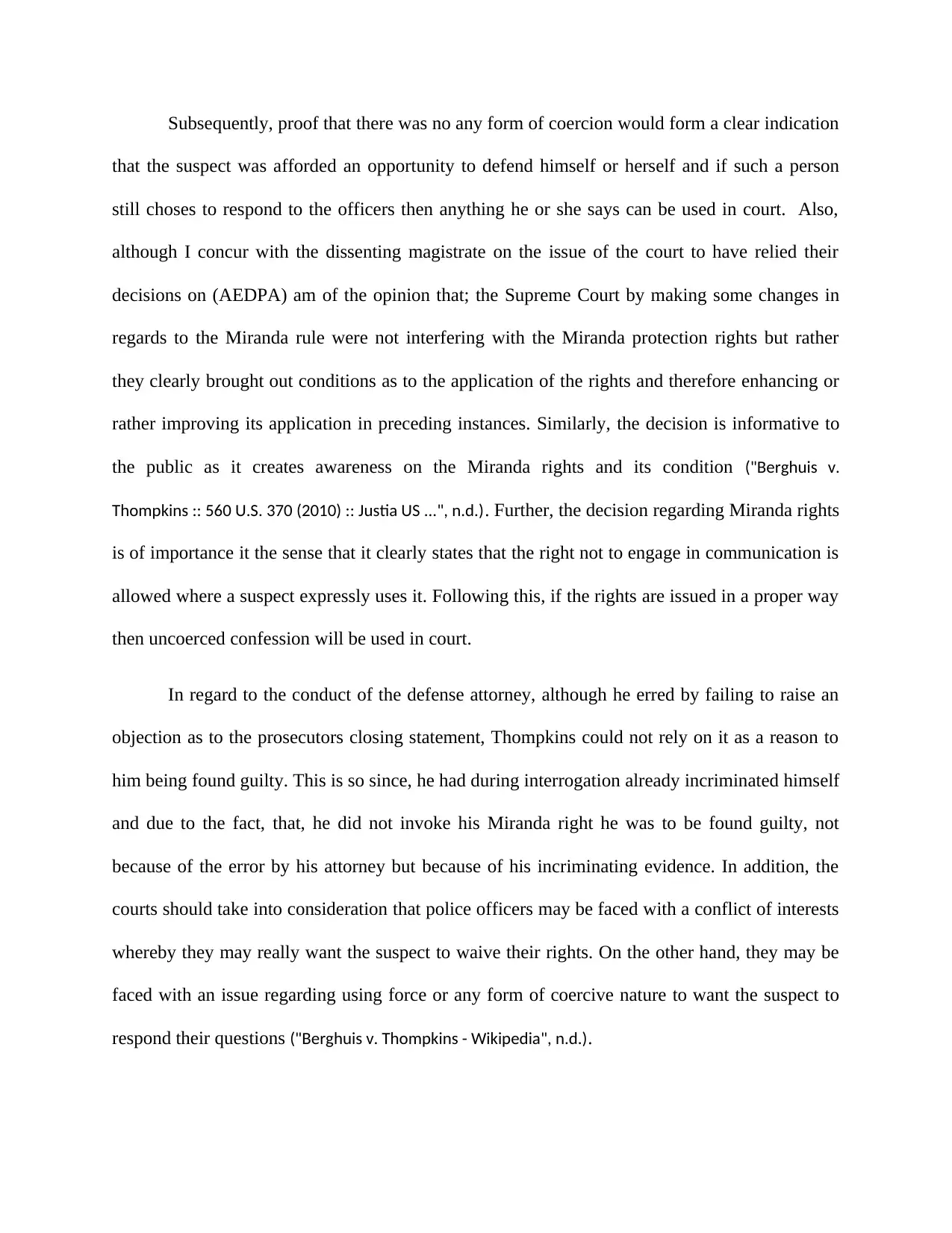
Subsequently, proof that there was no any form of coercion would form a clear indication
that the suspect was afforded an opportunity to defend himself or herself and if such a person
still choses to respond to the officers then anything he or she says can be used in court. Also,
although I concur with the dissenting magistrate on the issue of the court to have relied their
decisions on (AEDPA) am of the opinion that; the Supreme Court by making some changes in
regards to the Miranda rule were not interfering with the Miranda protection rights but rather
they clearly brought out conditions as to the application of the rights and therefore enhancing or
rather improving its application in preceding instances. Similarly, the decision is informative to
the public as it creates awareness on the Miranda rights and its condition ("Berghuis v.
Thompkins :: 560 U.S. 370 (2010) :: Justia US ...", n.d.). Further, the decision regarding Miranda rights
is of importance it the sense that it clearly states that the right not to engage in communication is
allowed where a suspect expressly uses it. Following this, if the rights are issued in a proper way
then uncoerced confession will be used in court.
In regard to the conduct of the defense attorney, although he erred by failing to raise an
objection as to the prosecutors closing statement, Thompkins could not rely on it as a reason to
him being found guilty. This is so since, he had during interrogation already incriminated himself
and due to the fact, that, he did not invoke his Miranda right he was to be found guilty, not
because of the error by his attorney but because of his incriminating evidence. In addition, the
courts should take into consideration that police officers may be faced with a conflict of interests
whereby they may really want the suspect to waive their rights. On the other hand, they may be
faced with an issue regarding using force or any form of coercive nature to want the suspect to
respond their questions ("Berghuis v. Thompkins - Wikipedia", n.d.).
that the suspect was afforded an opportunity to defend himself or herself and if such a person
still choses to respond to the officers then anything he or she says can be used in court. Also,
although I concur with the dissenting magistrate on the issue of the court to have relied their
decisions on (AEDPA) am of the opinion that; the Supreme Court by making some changes in
regards to the Miranda rule were not interfering with the Miranda protection rights but rather
they clearly brought out conditions as to the application of the rights and therefore enhancing or
rather improving its application in preceding instances. Similarly, the decision is informative to
the public as it creates awareness on the Miranda rights and its condition ("Berghuis v.
Thompkins :: 560 U.S. 370 (2010) :: Justia US ...", n.d.). Further, the decision regarding Miranda rights
is of importance it the sense that it clearly states that the right not to engage in communication is
allowed where a suspect expressly uses it. Following this, if the rights are issued in a proper way
then uncoerced confession will be used in court.
In regard to the conduct of the defense attorney, although he erred by failing to raise an
objection as to the prosecutors closing statement, Thompkins could not rely on it as a reason to
him being found guilty. This is so since, he had during interrogation already incriminated himself
and due to the fact, that, he did not invoke his Miranda right he was to be found guilty, not
because of the error by his attorney but because of his incriminating evidence. In addition, the
courts should take into consideration that police officers may be faced with a conflict of interests
whereby they may really want the suspect to waive their rights. On the other hand, they may be
faced with an issue regarding using force or any form of coercive nature to want the suspect to
respond their questions ("Berghuis v. Thompkins - Wikipedia", n.d.).
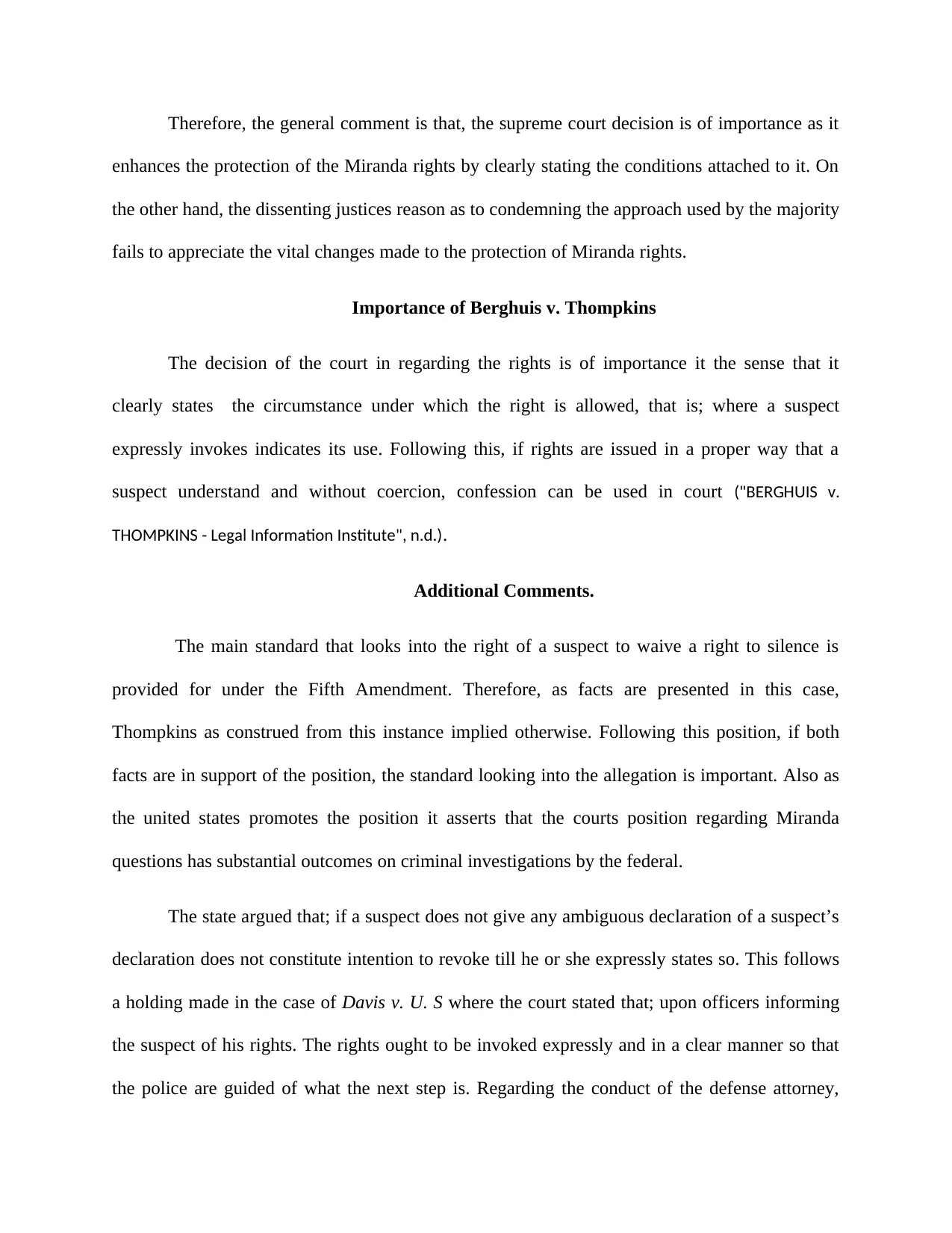
Therefore, the general comment is that, the supreme court decision is of importance as it
enhances the protection of the Miranda rights by clearly stating the conditions attached to it. On
the other hand, the dissenting justices reason as to condemning the approach used by the majority
fails to appreciate the vital changes made to the protection of Miranda rights.
Importance of Berghuis v. Thompkins
The decision of the court in regarding the rights is of importance it the sense that it
clearly states the circumstance under which the right is allowed, that is; where a suspect
expressly invokes indicates its use. Following this, if rights are issued in a proper way that a
suspect understand and without coercion, confession can be used in court ("BERGHUIS v.
THOMPKINS - Legal Information Institute", n.d.).
Additional Comments.
The main standard that looks into the right of a suspect to waive a right to silence is
provided for under the Fifth Amendment. Therefore, as facts are presented in this case,
Thompkins as construed from this instance implied otherwise. Following this position, if both
facts are in support of the position, the standard looking into the allegation is important. Also as
the united states promotes the position it asserts that the courts position regarding Miranda
questions has substantial outcomes on criminal investigations by the federal.
The state argued that; if a suspect does not give any ambiguous declaration of a suspect’s
declaration does not constitute intention to revoke till he or she expressly states so. This follows
a holding made in the case of Davis v. U. S where the court stated that; upon officers informing
the suspect of his rights. The rights ought to be invoked expressly and in a clear manner so that
the police are guided of what the next step is. Regarding the conduct of the defense attorney,
enhances the protection of the Miranda rights by clearly stating the conditions attached to it. On
the other hand, the dissenting justices reason as to condemning the approach used by the majority
fails to appreciate the vital changes made to the protection of Miranda rights.
Importance of Berghuis v. Thompkins
The decision of the court in regarding the rights is of importance it the sense that it
clearly states the circumstance under which the right is allowed, that is; where a suspect
expressly invokes indicates its use. Following this, if rights are issued in a proper way that a
suspect understand and without coercion, confession can be used in court ("BERGHUIS v.
THOMPKINS - Legal Information Institute", n.d.).
Additional Comments.
The main standard that looks into the right of a suspect to waive a right to silence is
provided for under the Fifth Amendment. Therefore, as facts are presented in this case,
Thompkins as construed from this instance implied otherwise. Following this position, if both
facts are in support of the position, the standard looking into the allegation is important. Also as
the united states promotes the position it asserts that the courts position regarding Miranda
questions has substantial outcomes on criminal investigations by the federal.
The state argued that; if a suspect does not give any ambiguous declaration of a suspect’s
declaration does not constitute intention to revoke till he or she expressly states so. This follows
a holding made in the case of Davis v. U. S where the court stated that; upon officers informing
the suspect of his rights. The rights ought to be invoked expressly and in a clear manner so that
the police are guided of what the next step is. Regarding the conduct of the defense attorney,
⊘ This is a preview!⊘
Do you want full access?
Subscribe today to unlock all pages.

Trusted by 1+ million students worldwide
1 out of 17
Your All-in-One AI-Powered Toolkit for Academic Success.
+13062052269
info@desklib.com
Available 24*7 on WhatsApp / Email
![[object Object]](/_next/static/media/star-bottom.7253800d.svg)
Unlock your academic potential
Copyright © 2020–2026 A2Z Services. All Rights Reserved. Developed and managed by ZUCOL.